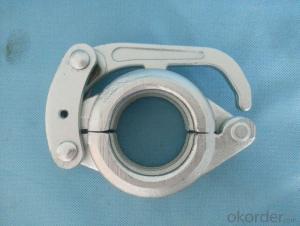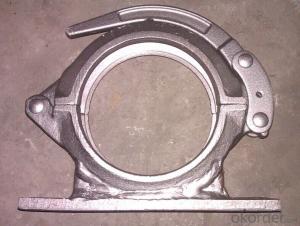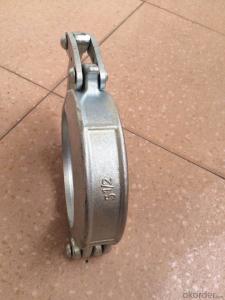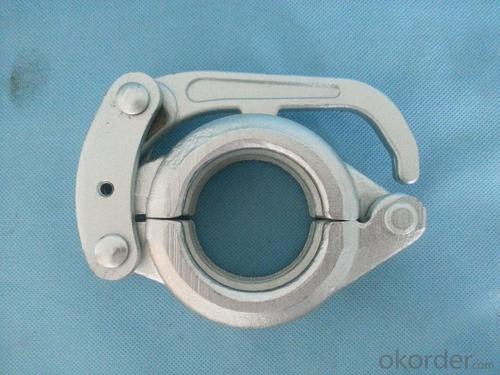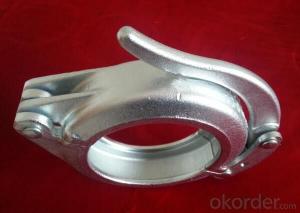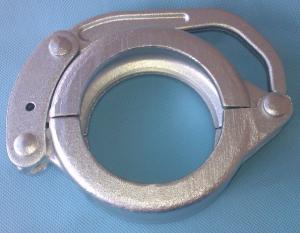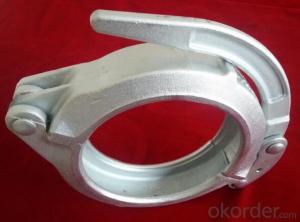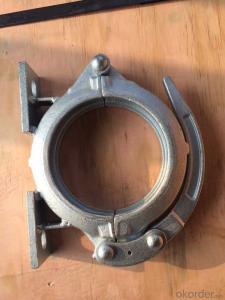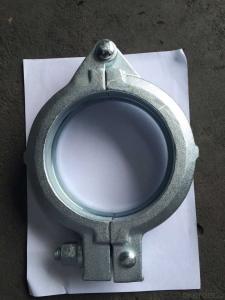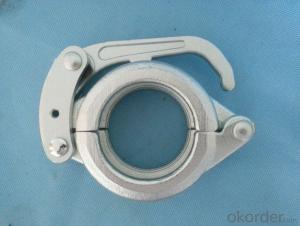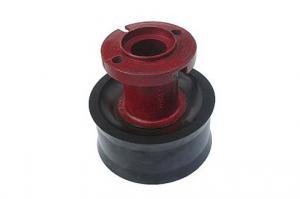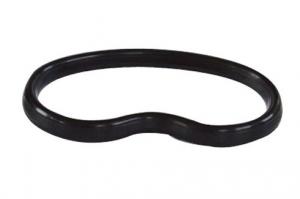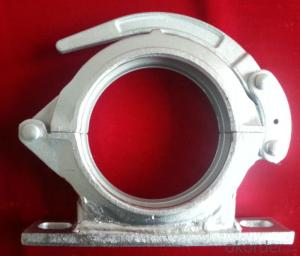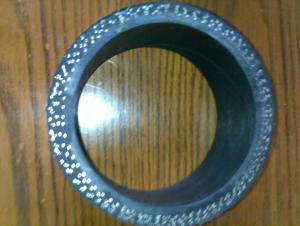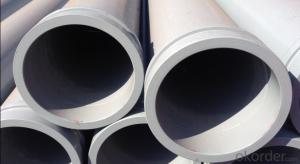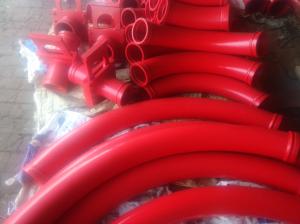Concrete Pump Part Forged Clamp Coupling DN50
- Loading Port:
- China main port
- Payment Terms:
- TT OR LC
- Min Order Qty:
- 50 PCS
- Supply Capability:
- 1000 PCS/month
OKorder Service Pledge
OKorder Financial Service
You Might Also Like
Product Description:
A coupling is a device used to connect two delivery pieps together at their ends for the purpose of transmitting, and prevent the concrete from leaking. Couplings do not normally allow disconnection of shafts during operation.
Main Product Features:
1. Use high quality steel. After high-temperature 1200 forging,it’s shaped.
2.High temperature forging.
3.convenient to use, easy operation,and high safety.
4.good sealing,wear-resising,longer service life.
5.do not restrict the steering tubes, pipes during the working process can be 360 degrees rotation.
6.used in concrete pump truck,concrete pump and pipeline connection seal in construction
work equipment.
Product Specifications:
1.Forged
2.2--8 inch
3.Galvanizing/Baking varnish
4.More durable,light,beautiful
Production steps:
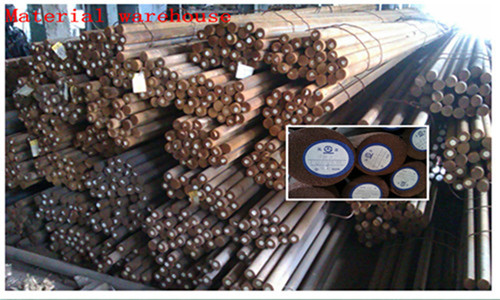
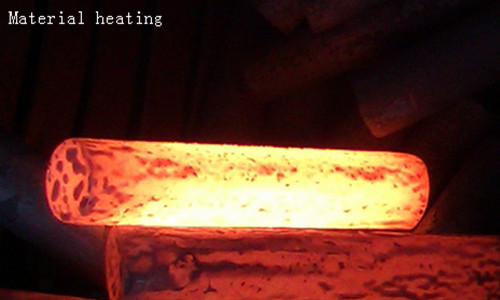
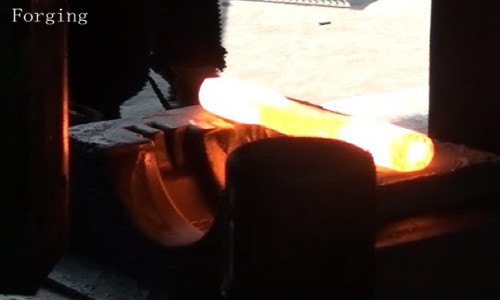
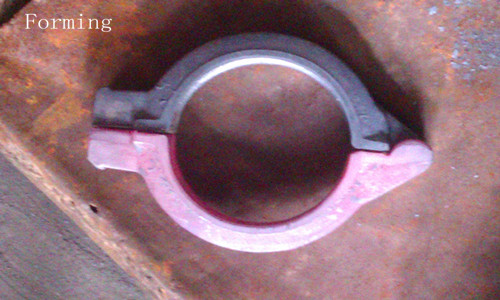
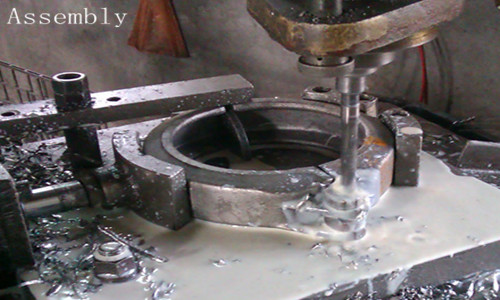
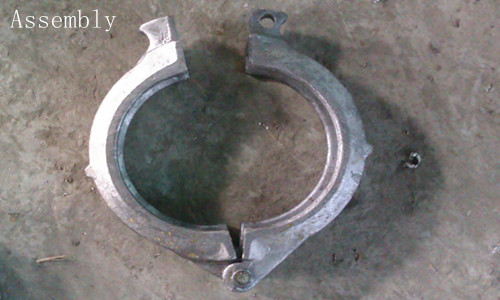
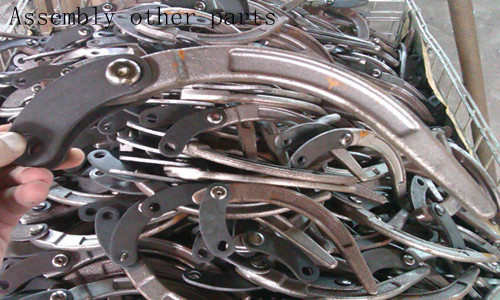
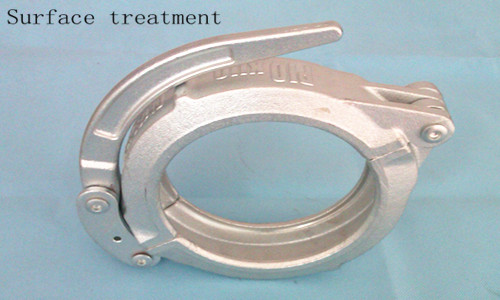
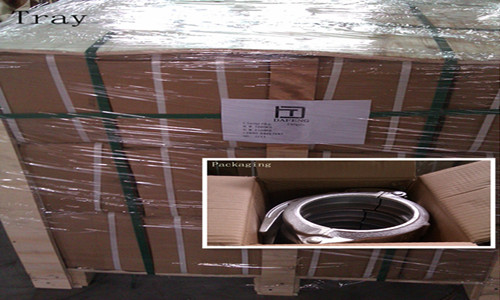
Concrete pump clamp Catalogue
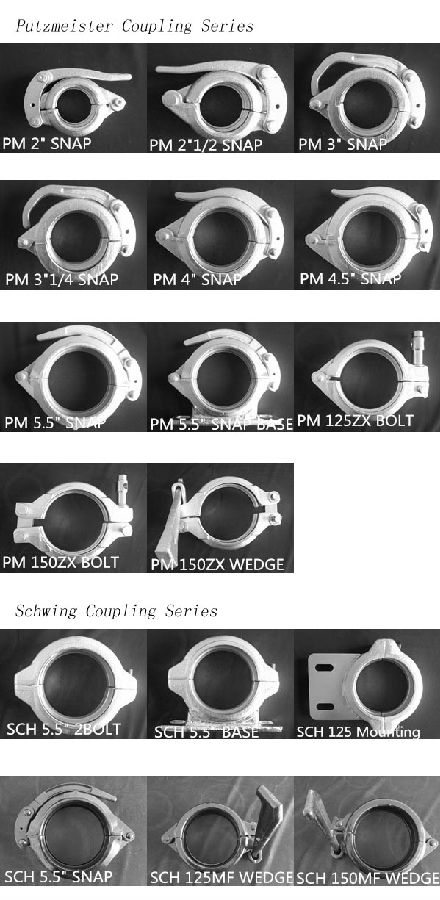
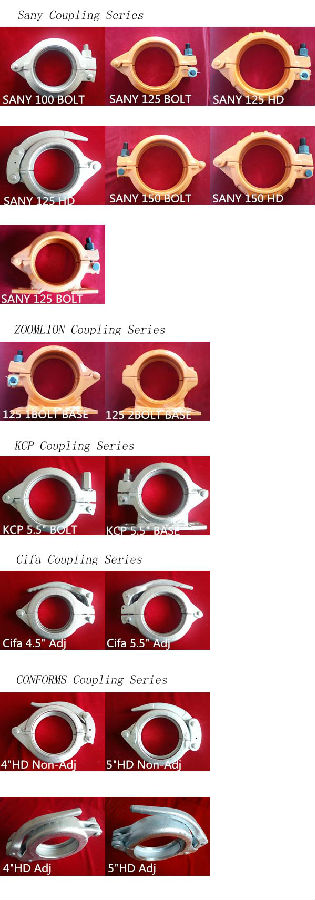
FAQ
1.How do you regarding your product quality?
As our principle is more safety to save more. In China, there are lots of manufactures of this line, but we are the first one that use the forging technic in producing, firmly meet the PM standard.
2.Can I get some samples?
Of course you can. Small sample for free, but you pay the express. For some products are not small, like concrete pump pipe, it’s very difficult to deliver one pipe of 3000mm. If it’s possible, we’d like that you can come here to visit our factory. Welcome!
3. I want to make our logo on the products, is that ok?
Yes, it’s totally ok. OME is available from us.What you should do is send your logo, brand name, or picture to us. And let other things leave on us.
- Q: How do I properly maintain and replace hydraulic hoses in concrete pump spare parts?
- Proper maintenance and replacement of hydraulic hoses in concrete pump spare parts is crucial to ensure the smooth functioning and longevity of your equipment. Here are some steps you can follow to maintain and replace hydraulic hoses effectively: 1. Regular Inspection: Conduct regular visual inspections of the hoses to identify any signs of wear, damage, or leaks. Look for bulges, cracks, abrasions, or fraying at the ends of the hoses. Pay attention to fittings, connections, and bends in the hose as these areas are prone to damage. 2. Preventative Maintenance: Implement a preventive maintenance schedule to reduce the chances of unexpected hose failure. This includes cleaning the hoses regularly to remove dirt, debris, and concrete residues that may cause abrasion or clogging. Use a mild detergent and water to clean the hoses, and ensure they are thoroughly dried before use. 3. Proper Storage: When not in use, store hydraulic hoses in a clean, dry, and temperature-controlled environment. Protect them from direct sunlight, extreme temperatures, and chemicals, as these factors can degrade the hoses over time. 4. Correct Handling: Always handle hydraulic hoses with care to prevent damage. Avoid dragging them on rough surfaces or sharp edges that can cause cuts or abrasions. Do not allow the hoses to kink or twist excessively, as this can weaken the internal structure. 5. Timely Replacement: Replace hydraulic hoses as soon as you notice signs of wear, damage, or leaks. Do not wait for hose failure, as it can lead to costly downtime and potential safety hazards. Follow the manufacturer's recommendations for the replacement interval, which may vary based on the type of hose and its usage. 6. Use Quality Replacement Hoses: When replacing hydraulic hoses, ensure that you use high-quality hoses that are compatible with your concrete pump. Choose hoses that meet industry standards and specifications, as they are designed to withstand the demanding conditions of concrete pumping. 7. Proper Installation: Properly install the replacement hoses, ensuring that they are correctly routed and securely connected to the fittings. Use appropriate tools and techniques to tighten the fittings, avoiding over-tightening that can damage the hose or fittings. 8. Regular Training: Provide regular training to your staff on proper maintenance, inspection, and replacement procedures for hydraulic hoses. This will enhance their knowledge and skills, reducing the risks of improper handling or installation. By following these steps, you can effectively maintain and replace hydraulic hoses in concrete pump spare parts, ensuring the safety and efficiency of your equipment. Remember to consult the manufacturer's guidelines and seek professional assistance whenever necessary.
- Q: Can concrete pump spare parts be customized for specific pump models?
- Customization of concrete pump spare parts is possible for specific pump models. Concrete pumps are available in various sizes and designs, and each model may have distinct specifications and requirements for its spare parts. To ensure compatibility and achieve optimal performance, it is essential to customize the spare parts according to the particular pump model. This customization may involve adjusting dimensions, materials, and other technical specifications to suit the specific pump model. By customizing the spare parts, a perfect fit is ensured, and the efficiency and longevity of the concrete pump are improved. Furthermore, customization allows for potential enhancements or modifications to the original design, resulting in superior performance and durability of the pump. Therefore, it is vital to collaborate with reputable manufacturers or suppliers who can provide customized concrete pump spare parts for specific pump models.
- Q: How often should concrete pump pistons be replaced?
- The frequency at which concrete pump pistons should be replaced depends on various factors such as the usage, maintenance, and the quality of the pistons. In general, it is recommended to inspect the pistons regularly for signs of wear and tear, including cracks, pitting, or scoring. If any of these signs are observed, it is advisable to replace the pistons immediately to prevent potential failures or leaks. Concrete pump pistons typically have a lifespan ranging from 25,000 to 75,000 cubic yards of concrete pumped, but this can vary based on the specific conditions and operating practices. For instance, if the concrete being pumped contains abrasive materials or if the pump is used intensively or under harsh conditions, the pistons may wear out more quickly. Additionally, proper maintenance practices can extend the lifespan of the pistons. This includes regular cleaning and lubrication, keeping the pump well-maintained, and ensuring that the pistons are properly aligned and not subjected to excessive pressure or stress. Ultimately, it is crucial to monitor the condition of the pistons closely and consult the manufacturer's recommendations or seek advice from a professional to determine the appropriate replacement interval for the specific concrete pump being used.
- Q: How often should a concrete pump wear plate be replaced?
- The frequency at which a concrete pump wear plate should be replaced depends on several factors, including the type of concrete being pumped, the volume of concrete being pumped, and the quality and maintenance of the pump itself. However, as a general guideline, it is recommended to inspect the wear plate regularly, especially after each concrete pour, to assess its condition. Typically, a concrete pump wear plate should be replaced when it becomes significantly worn or damaged. Signs of wear may include excessive grooves, cracks, or holes on the surface of the plate. This can affect the efficiency and performance of the pump, leading to decreased output and potential leaks. In high-intensity pumping operations or when abrasive materials are used, the wear plate may wear out faster and need to be replaced more frequently. On the other hand, if the pump is used less frequently or with less abrasive materials, the wear plate may last longer. It is important to note that regular maintenance and proper cleaning of the wear plate can extend its lifespan. This includes removing any hardened concrete residue and ensuring a smooth and clean surface. Lubricating the plate with suitable products can also help reduce friction and wear. Ultimately, it is recommended to consult the manufacturer's guidelines and seek advice from experienced professionals to determine the optimal replacement schedule for a concrete pump wear plate, considering the specific conditions and usage of the pump.
- Q: Are there any specific warranty options available for concrete pump spare parts?
- Concrete pump spare parts come with specific warranty options that provide customers with peace of mind and assurance of quality. Manufacturers and suppliers offer warranties on their products, which may vary depending on the provider. These warranties generally cover defects in materials or workmanship. It is advisable to carefully read and understand the warranty terms and conditions before purchasing concrete pump spare parts. This will help customers determine what is covered and for how long. Some warranties have limited coverage, while others offer extended warranties for an additional fee. It is crucial to adhere to the recommended maintenance and usage guidelines to ensure the warranty remains valid. If any issues or concerns arise during the warranty period, customers can typically reach out to the manufacturer or supplier for assistance.
- Q: What is the function of a concrete pump hopper filter?
- The function of a concrete pump hopper filter is to prevent large debris and foreign objects from entering the pump system, ensuring smooth and uninterrupted flow of concrete and protecting the pump from potential damage.
- Q: What are the precautions for gas washing of concrete pump?
- Subsection blowing, should first blow off near the discharge end of a pipe, then has blown the empty tubes connected with not purged during the purge, the remaining part.
- Q: Can I get spare parts for both piston and rotary concrete pumps?
- Yes, you can get spare parts for both piston and rotary concrete pumps. Many manufacturers and suppliers offer a wide range of spare parts for these types of pumps. These parts include but are not limited to pistons, seals, valves, wear plates, hydraulic components, and bearings. It is important to ensure that you purchase genuine spare parts from reputable suppliers to ensure the quality and compatibility with your specific pump model. Additionally, it is recommended to have a regular maintenance and inspection schedule for your concrete pump to identify any worn-out parts and replace them promptly to avoid any potential breakdowns or disruptions in your construction projects.
- Q: How long does it take to replace a specific concrete pump spare part?
- The time it takes to replace a specific concrete pump spare part can vary depending on factors such as the complexity of the part, availability of the replacement, and the experience of the technician. Generally, it can take anywhere from a few hours to a few days for the replacement process to be completed.
- Q: How do I properly maintain and replace wear plates in concrete pump spare parts?
- Achieving optimal performance and durability for your equipment relies heavily on the proper maintenance and replacement of wear plates in concrete pump spare parts. To ensure that your wear plates are adequately maintained and replaced, the following steps can be taken: 1. Conduct regular inspections: It is crucial to regularly inspect the wear plates in your concrete pump spare parts in order to identify any signs of wear or damage. Look for visible indications such as cracks, excessive wear, or deterioration. 2. Thoroughly clean the area: Prior to replacing the wear plates, it is essential to thoroughly clean the surrounding area. Remove any debris, dirt, or hardened concrete that may be present. Utilize a pressure washer or wire brush to effectively clean the surface. 3. Measure the thickness of wear plates: Utilize a precision measuring tool to determine the thickness of the wear plates. Compare the current thickness with the manufacturer's recommended specifications to determine if replacement is necessary. If the wear plates are below the recommended thickness, replacement is required. 4. Remove the old wear plates: Carefully remove the old wear plates using the appropriate tools. Take note of their positions and any alignment marks to ensure proper installation of the new plates. 5. Prepare the new wear plates: Prior to installing the new wear plates, verify that they are the correct size and meet the required specifications for your concrete pump. Inspect the new plates for any defects or damage before proceeding. 6. Apply lubrication: Apply a thin layer of lubricant or anti-seize compound to the mating surface of the new wear plates. This will aid in preventing corrosion and facilitate future replacements. 7. Install the new wear plates: Position the new wear plates accurately, aligning them with any reference marks or indicators. Secure them tightly using suitable bolts or fasteners, taking care not to overtighten. 8. Test and check alignment: After installing the new wear plates, perform a test run of the concrete pump to ensure proper functionality. Check for any leaks, uncommon vibrations, or misalignments. If any issues are detected, address them promptly. 9. Establish a regular maintenance schedule: To prevent premature wear and damage to the wear plates, create a routine maintenance schedule. This may involve cleaning, lubricating, and inspecting the wear plates at specified intervals or after a certain number of operational hours. By adhering to these steps and adopting a proactive approach to wear plate maintenance and replacement, you can guarantee the seamless operation and extended lifespan of your concrete pump spare parts.
Send your message to us
Concrete Pump Part Forged Clamp Coupling DN50
- Loading Port:
- China main port
- Payment Terms:
- TT OR LC
- Min Order Qty:
- 50 PCS
- Supply Capability:
- 1000 PCS/month
OKorder Service Pledge
OKorder Financial Service
Similar products
Hot products
Hot Searches
Related keywords
